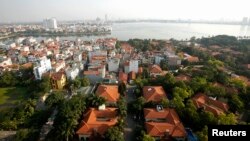Tran Ai has a dilemma every time she looks for a new house. If she can afford it, the place doesn’t have a deed; if the house does have its papers in order, the price is too high.
Years after a Vietnamese real estate bubble reached its worst, housing remains unattainable for the majority of the population, even middle class people like Ai, a 30-year-old software programmer.
“I just need a normal place to live,” said Ai, who is living with her mother and two sisters in a house owned by her aunt. “Something that protects us from the rain and the sun. A place where we can sleep and be at ease. Nothing too major.”
The kind of simple housing Ai wants is hard to find, in part because of the property bubble. Credit was cheap and the economy was growing by as much as 8.4 percent in 2005. That encouraged many investors, particularly institutional investors and state firms expanding beyond their main businesses, to pour money into the real estate sector. The speculation was based on expectations that housing prices would only go up, not because of actual demand from Vietnamese consumers. So the investments focused on luxury condos, and when the bubble stopped growing, Vietnam was left with a lot of pricey units on its hands.
Supply and demand
The result has been a mismatch in supply and demand. Plenty of ordinary Vietnamese like Ai are seeking affordable housing. But what’s on the market tends to be out of their reach financially.
“Most buildings go to the high class, the high-end sector,” Nguyen Tran Nam, deputy minister of construction, said at a real estate forum in September. Nam said 80 percent of people can’t afford these condos, even though the government stepped in to contain the luxury housing bubble. “We stopped that just in time, but already, the damage was done.”
Since then, Hanoi has ramped up efforts to make housing available to the masses at more reasonable prices. In 2013, for instance, the central bank unveiled a $1.4 billion loan program that offered mortgages to low-income Vietnamese at six-percent interest.
People have questioned the success of the program, with some applicants complaining that they couldn’t take advantage of the cheap loans because they limited the size and cost of the apartments, which sometimes were located in areas that were flood-prone or far from the city center.
Nam noted that the state also has built more housing for students, a key initiative because so many Vietnamese leave their rural hometowns to study in the cities.
Many projects are being “rolled out in the country for poor people,” Nam said.
Market shift
On the private sector side, policymakers have pushed developers to convert their commercial housing into “nha o xa hoi,” or social housing projects, while developers have tried breaking up their expensive property into units that are easier to sell. Companies have said the market is shifting, with more emphasis on smaller units at lower costs.
“The new affordable housing market is really where the mid-market was a few years ago,” Marc Townsend, managing director at CBRE Vietnam, said at the property forum.
Vietnam faces pressure to clean up the real estate market because it contributes 10 percent of gross domestic product, according to Nam.
The sector also is responsible for most of the loans that have gone sour in recent years because state-owned companies had easy access to financing, which they often funneled into property investments.
When the economy tanked, these firms couldn’t repay their loans, leaving Vietnam with a high ratio of bad debt that remains one of the top obstacles to strong economic growth today.







